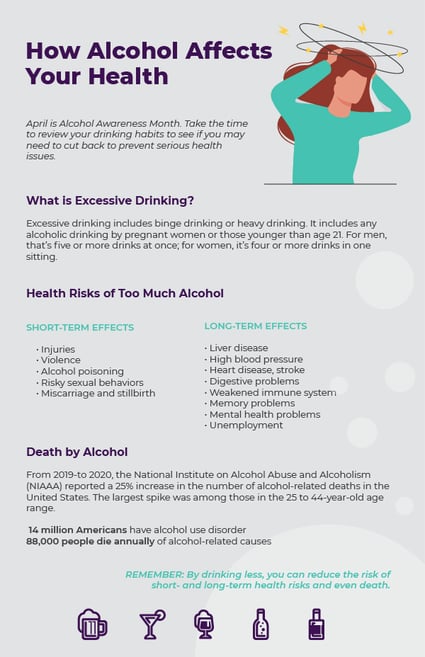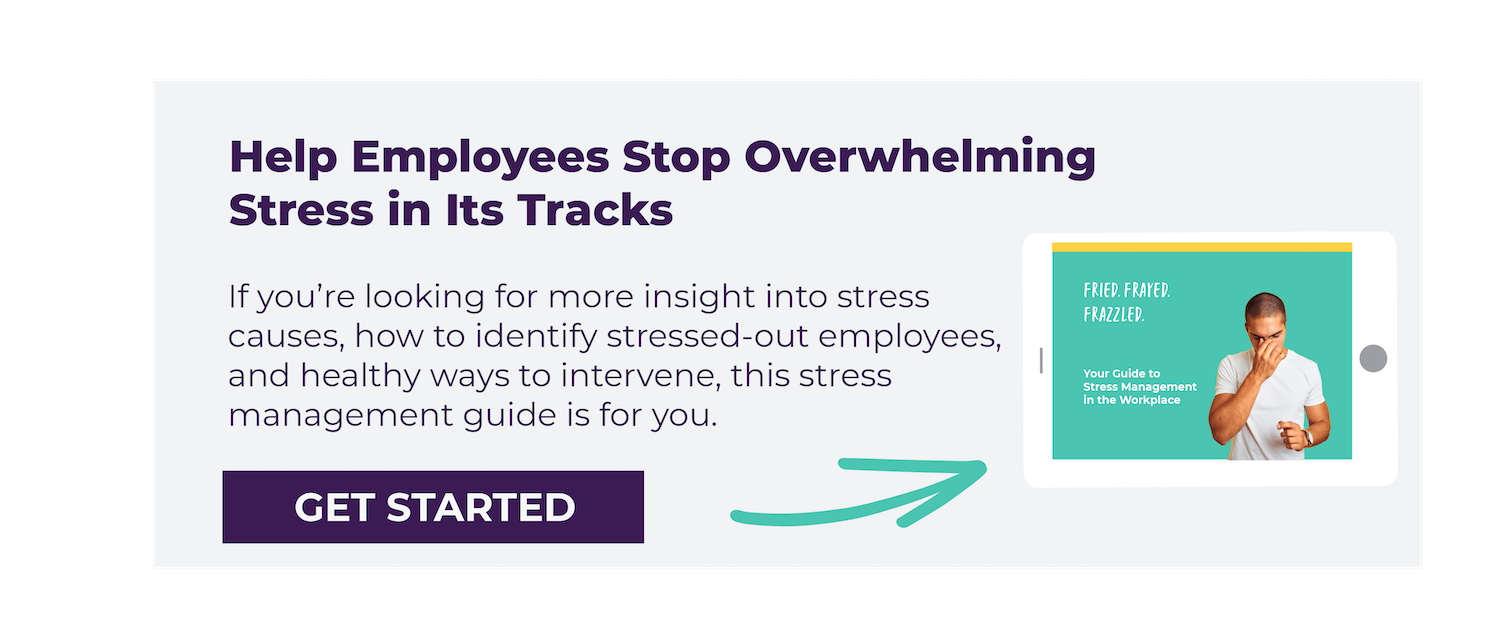 April is Alcohol Awareness Month, an ideal time to bring awareness to drinking habits.
April is Alcohol Awareness Month, an ideal time to bring awareness to drinking habits.
By bringing awareness to the issue, employees can reflect on how their alcohol consumption impacts their health — both in the short-term and long-term.
It’s worth talking about in the workplace as 232 million workdays a year are lost due to alcohol use disorder — and the rise in alcohol consumption during the pandemic suggests the number is going in the wrong direction.
Take the time this month to discuss with employees the topic of alcohol addiction and its associated health risks.
When Does Alcohol Use Become a Health Issue?
If alcohol use is negatively impacting your life — personally or professionally — it’s time to look at drinking patterns and how serious of an issue it may be.
If you drink:
- To the point of “blacking out”
- More or longer than intended
- To relieve pain (emotional or physical)
- To reduce anxiety and irritation
- To relieve stress and/or “forget problems”
…you could be heading into or are already in addiction territory with alcohol. Alcohol use disorder ranges from moderate to severe and is a medical diagnosis.
Health Issues Caused by Too Much Alcohol
Sadly, more than 14 million Americans meet the criteria for alcohol use disorder, according to the American Centers for Addiction website. The pandemic didn’t help lower those numbers, either. Harvard recently released a study that found a one-year increase in alcohol consumption during the COVID-19 pandemic will result in 8,000 additional deaths from alcohol-related liver disease. It will also be the cause of 18,700 cases of liver failure and 1,000 cases of liver cancer by 2040.
Short-Term Health Risks
Anyone who has experienced too much alcohol knows how quickly a “fun time” can turn unpleasant. Excessive alcohol use has immediate effects that increase the risk of certain health issues.
Most commonly occurring after binge drinking, you may experience:
- Injuries
- Alcohol poisoning
- Risky sexual behaviors
- Violence, including homicide, suicide, sexual assault
- Miscarriage, and stillbirth or fetal alcohol spectrum disorders (FASDs)
Long-Term Health Risks
Excessive, long-term use of alcohol can cause significant health issues for individuals. For those already experiencing health concerns, the health issues may worsen quickly.
Here’s a list of long-term health risks related to overuse of alcohol:
- Liver disease
- High blood pressure
- Heart disease, stroke
- Digestive problems
- Weakened immune system
- Learning and memory problems, including dementia
- Mental health problems, including depression and anxiety
- Social problems (family problems, job-related problems, and unemployment)
Additional Health Concerns
- Increased cancer risk - Recent studies on alcohol abuse also indicate there are greater links between alcohol use and cancer. Emerging evidence suggests alcohol is the direct cause of at least seven different cancers, yet most of the public isn’t aware of this.
- Even one extra drink ages the brain - Even newer research — using a dataset of more than 36,000 adults — found increasing consumption from one to two drinks daily was associated with changes in the brain equal to aging two years, according to the University of Pennsylvania. Even more alarming: The aging and brain damage got worse the more participants drank.
Women Face Higher Risks
The National Institute on Alcohol Abuse and Alcoholism (NIAAA) reports that alcohol abuse is becoming more common among women. Unfortunately, studies indicate women are more likely to start having alcohol-related health issues sooner (and at lower drinking levels) than men due to weight and biological differences.
The NIAAA also reports, “women who regularly misuse alcohol are more likely than men who drink the same amount to develop alcoholic hepatitis, a potentially fatal alcohol-related liver condition.”
Men and women metabolize alcohol differently, too.
The Impact of Alcohol Use Disorder on the Workplace
Alcohol is the top abused drug in America. Like other drugs, it causes a loss of productivity and an increase in health care costs and accidents. Numerous studies report that the cost of alcohol abuse in the workplace ranges from $33 billion to $68 billion per year. Alcohol plays a huge role in injuries at both home and work, according to the U.S. Office of Personnel Management.
Alcohol and other substance abuse issues may often be looked at by others with disdain who think “that could never happen to me.” The truth is, anyone who drinks (and especially those with a family history of alcohol abuse) is at risk of developing an abusive relationship with alcohol.
Obvious signs of alcohol abuse:
- Body shakes
- Unsteady walking
- Bloodshot eyes
- Smelling of alcohol
- Falling asleep on the job
- Changes in mood and behavior
Other signs your employee may have a drinking problem:
- They miss deadlines often
- They are frequently tardy
- They turn in uncompleted work
- They miss Mondays and Fridays often
- They make careless mistakes often
Like other health issues — diabetes or heart disease, for example — alcohol use disorder should be treated as it’s considered a chronic disease. Being aware of employee behaviors — and approaching them with care — can make a difference.
Employees struggling with drinking problems are more likely to experience strained relationships with coworkers. Or, they may isolate themselves from others completely.
Note: Approaching someone dealing with signs of alcohol dependency is a sensitive matter. Because of this, some colleagues may be unsure of what to say or that they’ll offend someone if they approach them about their drinking habits. It’s best for human resources to know about the situation so they can appropriately handle the situation and document it.
For any employee who is obviously intoxicated in the workplace, the situation is always best resolved by a manager or higher leadership immediately.
Share These Resources During Alcohol Awareness Month
While it may be an uncomfortable topic, creating wellness campaigns around dealing with substance abuse may help more employees than you know. Alcohol Awareness Month is a prime time to have those discussions and resources circulating.
Many people keep their addictions a secret, often surprising loved ones when they find out someone close to them suffers in silence from addiction. By sharing these resources, your company may help employees help themselves or even a family member or friend struggling with alcohol use disorder.
The following free resources are available to share:
- National Institute on Alcohol Abuse and Alcoholism (NIAAA) - Gain a better understanding of the spectrum of alcohol use disorder through this article. Find out about various treatment types, including medicines, mutual-support groups, and behavioral treatments.
- Alcohol Use Screening Test - Print out and email this screening for employees to better understand if they’re struggling with alcohol use disorder.
- Alcohol awareness pamphlets and brochures - Get free copies of various NIAAA materials including how alcohol impacts pregnancy, treatment for alcohol, talking to kids about alcohol, and more.
- “Rethinking Drinking” Worksheets - Share the worksheets and informational sheets with employees to help them evaluate their drinking and if they need to make a lifestyle change.
Want more resources? Check out a variety of studies, reports, and fact sheets about alcohol abuse on the National Institute on Alcohol Abuse and Alcoholism (NIAAA) website.



